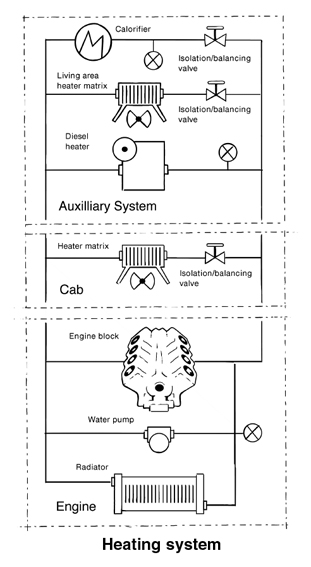'Fantastically detailed and well-presented.'
— Backpack magazine

Overlanders' Handbook
Excerpt:
Building a cabin
Contents | Introduction | Planning and preparation | Building a cabin | Sample route outline Asia: Syria & the Middle East | Southeast Asia | Contributors
This section covers building a shell or a box on a van or truck chassis. Many names are used for this space: shelter, living module, capsule, box and so on, but ‘cabin’, as opposed to the driving cab, is the term used here to define the area in the back where you spend time when not driving. Even if you’re only fitting out a 4x4 or a van, it’s worth scanning this section as it includes ideas that might be useful to all overland conversions.
Going step by step through the entire process of the build would take another book. Instead here’s an outline of the tasks involved, particularly the more obscure ones that won’t overlap with outfitting a regular motorhome. You’ll soon learn that certain brands such as Eberspächer heaters (Espar in North America), Seitz windows and doors, SMEV stove and sink assemblies, Thetford toilets and SHURflo pumps are universal in the campervan outfitting world, just as a limited range of marques get used for overlanding.
The many ways of equipping the cabin as a living space for the open road, are also covered in greater detail on many travellers’ websites and particularly in the UK on the Self-Build Motor Caravanners Club website (: www.sbmcc.co.uk), whose cheery motto is ’We Build, We Travel, We Enjoy‘. Hopefully while occupied by the first you’ll experience the latter.
Grand designs for the open road
To take on a self-build and be able to leave materials and tools for half-complete jobs out overnight you’ll need a secure space, not something that most people living in congested Europe have to spare. A big 4WD truck blocking out the sun on your suburban street could upset the neighbours so you may need to factor in the cost of renting a secure barn or warehouse (including bills for power, lighting and heating), as well as calculating what opportunities you’ll actually have to go there and get on with the job. Already having access to such a place is an incentive to take on such a project, a job that will undoubtedly take many months.
You need to consider everything from possibly devising a torsion-free subframe, fabricating a cabin shell to mount on that frame, cladding and weather-proofing it, insulating and lining it, fitting it out with storage compartments, worktops and furnishings, as well such installing a shower/toilet. Then you’ll need to devise an autonomous electrical power system, organise a way of storing, delivering and disposing of water used for drinking and washing, and address any heating requirements.
This section doesn’t intend to be comprehensive right down to the most suitable pattern for your fireproof curtains. Nor does it try to be definitive because your creativity, time, budget and preferences can lead you in any direction you choose. There is no single best way of building, mounting and outfitting a cabin, but there are a number of right ways. What you get here is the basic idea to realise what it takes to get the job done.
Don’t build, buy
Why would you do all this? After all, it’ll be a monumental task that’s extremely unlikely to pay back the expenditure on materials, let alone your time. Partly because to buy a professionally outfitted vehicle like this can cost much more than your trip, from at least £50,000 ($74,000) to well over ten times that figure for the truck-based, globe-trotting AWD penthouses produced in Germany or the US, among other places. And partly because you like the challenge of the project and think you could do a good job.
Remember, this ought not be some rat van to hang out in at summer festivals or for surfing weekends. Unless you intend to spend every other day making minor repairs, it all has to be either very simple and essentially unfitted – nothing wrong with that apart from the daily inconvenience – or built to a high standard. The latter is something that not every person has the patience, skill and dedication to achieve. For others it’s all part of the adventure but can take so much out of you that it’s not uncommon to find near-finished vehicles for sale that have never been used. For these creative pioneers the build was the adventurous journey and the momentum to break away and live the life on the road was lost. Right now I know of at least three overland-ready trucks going for around £35,000 ($44,000) in the UK. They’ll take months to sell and will probably go for a lot less, but will still cost less than it would take you to make an equivalent, so that is a budget you can expect to exceed on a big, well-equipped build. Today on eBay there’s a nearly finished 4WD Iveco camper for £5500 and a similar Renault/Dodge 50 with a caravan on the back for less than £4000; in Europe, particularly France and Germany, there are far more accomplished and exotic overlanders to be found. Australia too will have its share of great machines ready to go. Substantial savings can be made and months of work avoided by tracking down a used overland camper. The reason most people will carry on regardless is because they think it’ll be satisfying to design and build something of their own. In most cases they’ll be right, but just like building a house for the first time, it could be at some cost.
Not buying but spending
Long before you attack your vehicle with a chainsaw have a good think. Research thoroughly and try to visualise your living space long before you make any expensive purchases or irreversible alterations. This is a critical phase when many mistakes and false trails can be avoided. You want to have a near-crystal clear plan because, just like your overland journey, it’s unlikely to pan out as expected. There’s no optimal design, but there are several pitfalls and chances are you’ll return from your trip knowing exactly how to do things better next time.
Trawl the net of course, but if possible also try and actually see a few cabin interiors. Motorhome and caravan shows are a good place to do this. Even better are the much less common overlanding shows, pre-eminent being the German Abenteuer & Allrad show in Bad Kissingen in June (: www.abenteuer-allrad.de), the nascent Overland Expo in Arizona in April (: www.overlandexpo.com), or something like the Queensland Caravan Camping & Touring Holiday Show in Brisbane around mid-June (although every Australian state capital stages an equivalent). Bad Kissingen is the pick of the bunch, focused on overland travel not 4x4s, and is where you’ll see just about every permutation of overland camper and may even find your dream truck for sale.
Brits might be dyed-in-the-wool caravanners and the French keen motorhomers, but these Germans really are the experts in this niche field of building overland campers. The catalogues (all in German) from the likes of Woick, Tourfactory, AMR, Reimo (also in English), OutdoorWelt and, not least, Ormocar will give you an idea of the equipment and fittings available, as well as the thought-provoking prices.
Overlanders' Handbook
Excerpts:
- Contents
- Introduction
- Planning and preparation
- Building a cabin
- Sample route outline Asia: Syria & the Middle East
- Southeast Asia
- Contributors
Price: £19.99 buy online now…
Latest tweets